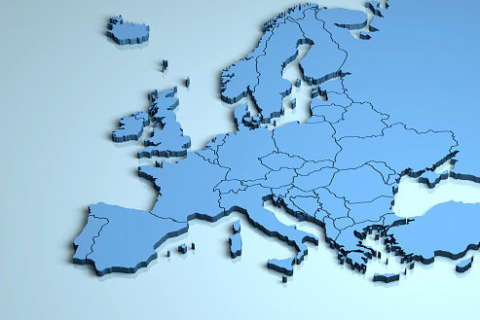The just-concluded European Union elections were yet another milestone for far-right parties on the continent. They racked up gains across many of the EU’s 27 countries, and the surprising scale of their victories is rattling the political establishment there and drawing attention in the United States.
The parties’ success embarrassed German Chancellor Olaf Scholz by outpacing his party and prompted French President Emmanuel Macron to call snap legislative elections.
While votes were still being tallied Tuesday, the gain for the right is just the latest example of how discontent with globalization and immigration have fueled a conservative, populist backlash in affluent Western democracies. Former President Donald Trump’s 2016 win was the strongest example of this, but it’s unclear whether the trends that powered the right in Europe will enable him to win another term in November.
That’s because, along with the striking parallels, there are key differences between the dynamics in Europe and the U.S. And even with the right’s gains in the most recent European elections there, the political center still is likely to retain control of the EU parliament.
“We’re clearly at one of those points where the wind can blow in either direction,” said Charlies A. Kupchan, a fellow at the Council on Foreign Relations.
WHAT FUELED THE RIGHT IN EUROPE?
All of the EU’s countries have different political dynamics, and the EU parliamentary elections are often an opportunity for voters in each country to take a symbolic vote against those in power in their own nation, since they’re voting for people who will take office in Brussels rather than their own capital. There’s also been a global backlash to incumbents that doesn’t seem to have any ideological basis.
But the right’s resurgence in Europe is more than symbolic or random. It’s been powered by frustration at the migrant crisis in the EU — frustration the right has been eager to amplify in online platforms — as well as regulations on climate change and other issues that have been seen as hitting rural, less-educated residents harder. Economic growth in much of Europe has been stagnant since the 2008 global recession, further powering discontent with the status quo.
Far right or populist parties now lead Italy and Slovakia and are part of ruling coalitions in other countries such as Finland, Sweden and, shortly, the Netherlands.
Generally, the right’s strongest support on the continent is among rural voters who have lower levels of education than urban ones who express greater comfort with the economic and social changes of globalization. All this probably sounds very familiar to U.S. voters, where there have been similar splits between Trump’s Republicans and President Joe Biden’s Democrats.
IS TRUMP RIDING THE SAME WAVE?
Trump has embraced the European right, especially Hungarian Prime Minister Viktor Orbán, whose self-styled “illiberal democracy” has made him an icon for conservative populists who believe in limiting immigration and LGBTQ+ rights. He’s endorsed multiple European conservative populists in their bids for national leadership, and some of Trump’s key advisers maintain ties with the movement across the Atlantic.
One of those former advisers, Steve Bannon, on Monday called the EU elections “a tectonic plate shift” on his podcast.
“It’s like here in the United States, it’s what MAGA does,” Bannon said, using the acronym for Trump’s Make America Great Again movement. “MAGA pulls us farther to the right. And I think that’s a, not just a good thing, it’s necessary for the nation and necessary for the world.”
Trump’s 2016 victory, despite losing the popular vote, was secured partly by pledging to build a wall between the U.S. and Mexico to limit immigration. This year, he has slammed Biden on the surge of migrants crossing the southern border seeking asylum in the U.S. Acknowledging the potency of the issue, Biden has shifted right on immigration by issuing new regulations to close the border if crossings are too high.
There are some key differences, however, between Trump and European populists, the most significant being their records on democracy. Trump tried to overturn his loss to Biden in 2020, culminating in the Jan. 6, 2021, attack on the U.S. Capitol. He has embraced that cause in his campaign to regain office, continuing to repeat the lie that he was cheated out of re-election by widespread fraud and calling those who stormed the Capitol “warriors” during a Las Vegas rally on Sunday.
Steven Levitsky, a Harvard political scientist and co-author of “How Democracies Die,” said that’s in sharp contrast with European populists.
“They’re much less openly authoritarian than Trump,” Levitsky said. “None of these guys have rejected election results.”
That’s been a political vulnerability for Trump, who continues to make false claims that the 2020 election was stolen. Biden has assailed him relentlessly over Jan. 6 and has signaled that he’ll make preserving democracy core to his campaign. Trump supporters who targeted state election offices lost in every swing state in 2022 and Democrats hope the same dynamic will protect Biden this year.
Kupchan said Trump’s voters may be angrier and more desperate than their European counterparts because of that continent’s robust social safety net.
“One reason the center has held in Europe and not in the U.S. is Americans have farther to fall,” he said. “If you’re a worker in Europe and you’ve lost your job on a VW production line, you’re hurting but you’re not in as much trouble as someone in Michigan.”
Trump’s strongest support has been among older voters, in contrast to European populists who experts say do better among younger voters. And in the American two-party system, the current election amounts to a game of chicken with voters, who will need to choose either Biden or Trump. The race may come down to who is the least distasteful to voters and whether third party candidates unable to gain any political power in the race will pull away enough votes to doom one of the two major party candidates.
It’s far from inevitable that Trump will win. Just look to Europe to see that conservative populism has its limits.
THE RIGHT CAN ONLY GO SO FAR
There have been limits to the right’s gains in Europe. Last year, Poland’s conservative populist government lost power as voters opted for a center-left coalition. The United Kingdom left the EU in a win for conservative populism, but its conservative Tory party is expected to lose big in upcoming elections, even if the opposition Labour party isn’t planning on reversing Brexit.
Even in the heart of conservative populism’s power in Europe, Hungary, there’s been mounting discontent with the incumbent government.
In places where the right has taken power, like Italy, where Prime Minister Giorgia Meloni’s party doubled the number of its members in the EU parliament, it has not been a radical break. Meloni has kept her country as part of the coalition supporting Ukraine’s fight against Russia. While she’s cracked down on admitting migrants who traverse the Mediterranean into the country, she and her neo-fascist-rooted Brothers of Italy party have not made any fundamental changes to the country’s political and economic structure.
Matthias Matthisj, a professor of international political economy at Johns Hopkins University, said Italy might be an example of how populists will govern in Europe.
“They’re going to be stricter on Muslim prayer and you can drive faster on the highway now,” Matthisj said. “But on the big stuff — the budget, foreign policy — the only way these populists can come to power is if they stay in the center.”
That’s in contrast to Trump, who has embraced striking shifts in U.S. policy and how the federal government might operate if he wins. Some analysts believe a Trump victory could give permission to European populists like Meloni to shift further right.
Even after the EU elections, radical change is unlikely. The Christian Democrats of EU President Ursula von der Leyen shifted rightward to counter the populist surge, and remain by far the largest party in the 720-member body. The center still holds in Europe — it just moved right. Whether that happens in the U.S. in November is the next question.
___
Associated Press write Ali Swenson in New York contributed to this report.
Copyright © 2024 The Associated Press. All rights reserved. This material may not be published, broadcast, written or redistributed.






